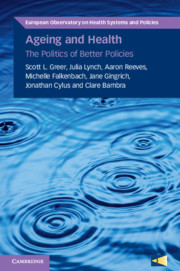Figures
1.1The shares of the population aged over 65 and 80 years in the OECD will increase significantly by 2050
2.1Percentage of people age 65+ who report they are able to make ends meet
2.4Predicted odds of reporting good health by age category and level of education
2.5Average retirement ages among men in OECD-34 countries, 1970 to 2016
2.6Labour income and consumption over the life-cycle, South Korea, 2012
3.1Share of the electorate in the last national election by age group, European countries
3.2Vote shares of party groups by age, 2019 European Parliament elections
4.2Differences in the degree of solidarity within and across generations
4.4Trends in elderly and working age poverty rates from the late 1990s to the early 2010s
4.5The number of mentions of welfare and education in political manifestos, by country
4.6Standardized population density versus country-year standardized age structure, NUTS-3 levels or equivalent, 2016
5.1Income inequalities in self-reported health across Europe, 2016
5.2Educational inequalities in non-communicable diseases in Europe
5.4Average life expectancy by European region for men and women
6.1Trends in absolute inequalities in infant mortality rate, 20 per cent most deprived local authorities compared to the rest of England, 1983 to 2017
6.2Trends in male life expectancy in Former East and West Germany to 2010
6.3Trends in female life expectancy in Former East and West Germany to 2010

